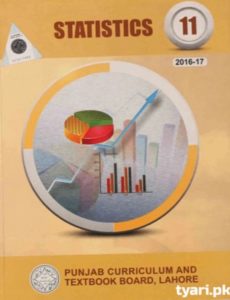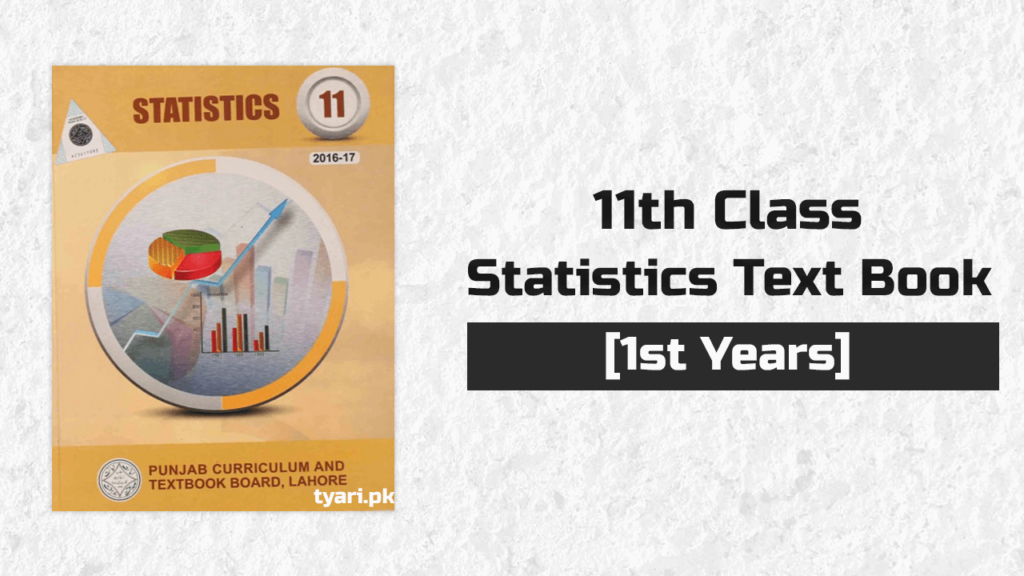11th class Statistics Text book [1st Years] – PDF & Read Online
Statistics book for class 11 Punjab board Book pdf Download and You can Also Read Online. This Statistics textbook is For 1st-year Students of FSC, ICS, F.A, and I.Com. This Book Only For those who don’t have access to the hard copy and Personal Use Only.
Download & Online Statistics Book 11th Class in English Pdf View:

Download Statistics Book (1st Years)
PDF Size: 76 MB
Statistics Text book pdf
11th Statistics class Book by Punjab textbook board
The 12th edition of the textbook of “STATISTICS” for class 11 has been co-authored by three subject specialists, ensuring standard measures for designing the book. The discipline concerns the collection and organization of data followed by its analysis and the methods that we adopt for its presentation.

It includes designing experiments, collection, organization, summarization, analysis, and interpretation of numerical data. Hence, the subject, along with the gathering of data, involves probability theory and applied mathematics.
What is inside the book?
The book comprises nine chapters. The book has two portions; the first one deals with statistics and the second one with probability. After introducing the subject and basic statistical terms through chapters 1 to 4, the book discusses a specific class about prices in terms of index numbers in its 5th chapter.
The remaining portion of the book, i.e., from chapter 6 to chapter 9 the book deals with probability. The 6th chapter introduces the student to probability, and some prerequisites like sets are discussed for establishing the ground for probability. Chapters 7, 8, and 9 contain the major portion of probability.
CHAPTER 1: Introduction to statistics
The first chapter is simply an introduction to the subject giving a brief history of the term statistics, its evolution with time, its definition. It discusses some statistical terms to make the students familiar with the basic concepts. Then the importance of the subject in various disciplines is discussed through its applications. After this, it dives into the statistical concepts of “Variables” and its types, “Descriptive and inferential statistics,” gives an understanding of the main aspects of a statistical problem, and in the end discusses the two classes of the sources from where the data can be obtained.
CHAPTER 2: Representation of data
The chapter elaborates the straightforward tabular and graphical methods used to represent the data in an understandable version. Cumulative frequency distribution as a tabular representation for discrete data has been elaborated, followed by the graphical representation of data through bar diagram, multiple bar diagram, histogram, frequency polygon, frequency curve, and scatter plots.
CHAPTER 3: Measure of location
The chapter is a comparatively lengthy one as it discusses the concepts along with their properties, calculations, merits, demerits, and how they are related to one another. It provides us with a quantitative analysis of the distributions indicating the center of the distribution and observation points relative to the others.
CHAPTER 4: Measure of dispersion
The chapter is about the spread of information in a set, i.e., the data variation. The terms variability and its types; Absolute measures and Relative measures, are defined. The measures of absolute variability discussed in detail in the chapter are Range, Quartile Deviation, Mean Deviation, Variance, Standard Deviation. In contrast, the only relative measure discussed in detail is the Coefficient of Variation, and other relative measures have been mentioned along with their formulae. The measures about the shape of distribution depend upon the moments and are discussed under skewness and kurtosis.
CHATER 5: Index numbers
What makes this chapter unique from all other chapters is that it specifically focuses on the data concerned with prices. The concept of Index numbers, used to measure the relative change in variables over time, has been provided here. The need, definition, construction, calculation, types, and limitations of the index number are given, followed by an explanation of the types and their calculation. At the end of the chapter, the meaning and construction of three price indices (CPI, SPI, WPI) calculated by the Federal Bureau of Statistics in the country are discussed regarding Pakistan, making it quite engaging.
CHATER 6: Probability
From here, the interesting part of the book starts. In the beginning, the chapter is simply a review of the set theory and then an introduction to probability. Methods to deal with problems concerned with chance events are developed in the chapter. It starts with an explanation of the set, its various types, and operations on sets.
CHAPTER 7: Random variables
The deeper and interesting concepts of probability start developing from this chapter as it introduces random variables. It defines random numbers and discusses how they are generated, briefly mentioning their applications. Then it explains the concept of random variables with the help of some examples ending the chapter with a minimal explanation of discrete and continuous random variables.
CHATER 8: Probability distributions
This chapter continues from the discussion at the end of chapter 7 about discrete and continuous random variables. It then defines the probability distributions for the two types of random variables, i.e., probability mass function for a discrete random variable and probability density function for a continuous random variable—their properties and applications of univariate discrete and continuous distributions. Graphical representation of the probability distribution through histogram and bar chart are presented. The terms Expectation, Variance, and Distribution function are explained with multiple examples.
CHATER 9: Binomial and hypergeometric probability distribution
The chapter deals with only those problems where we have just two possible outcomes, which can be classified as, success or failure. The main topics discussed in the chapter are Binomial probability distribution and Hypergeometric Distribution with their mean and variance.
How to study it effectively through PDF?
Studying statistics through a PDF is very challenging. The following are some effective tips to help you get through the 11th-grade statistics coursebook by studying with a PDF.
- Always keep a notebook and a pen with you to note down the difficult statements, page numbers, symbols, etc.
- Keep the internet turned off when you have downloaded the book.
- Make digital notes such as screenshots and screen recorded videos.
- Wear glasses to avoid any headache after prolonged screen exposure.
CONCLUSION
The book is quite simple from the beginning and trouble-free till the 8th chapter. It is just the last two chapters that require some good level of understanding of the simple concepts previously discussed in the book.
Note: You can download the 11th Class Statistics Full Book PDF (1st year Student). Get from Above Download Link or Directly from pctb.punjab.gov.pk.
